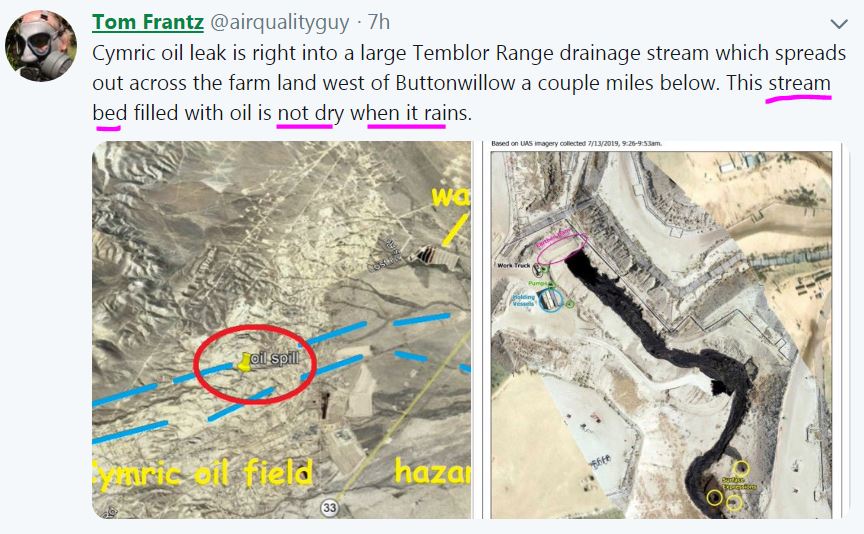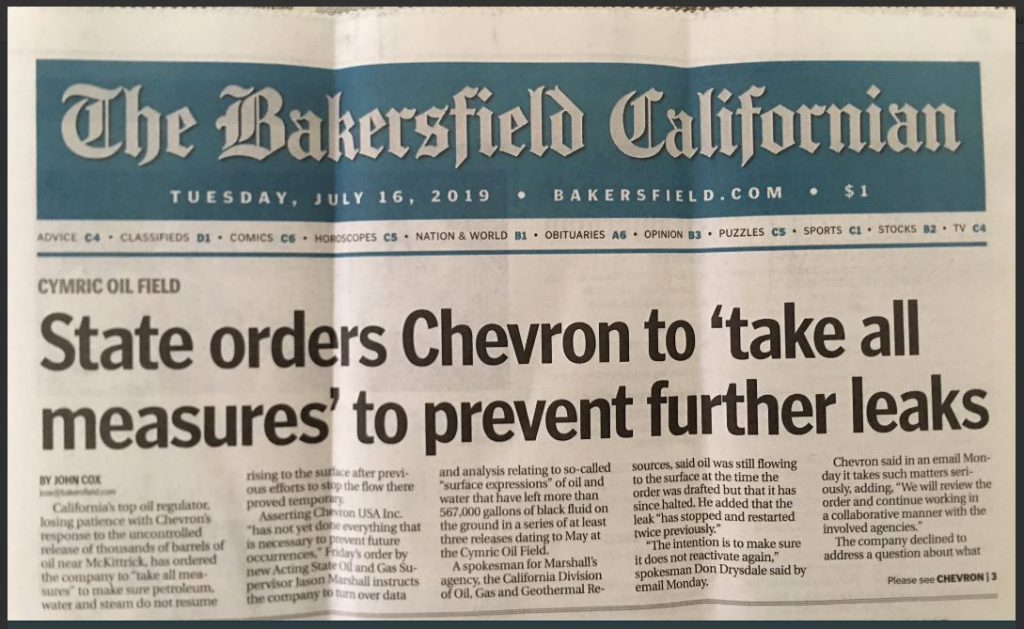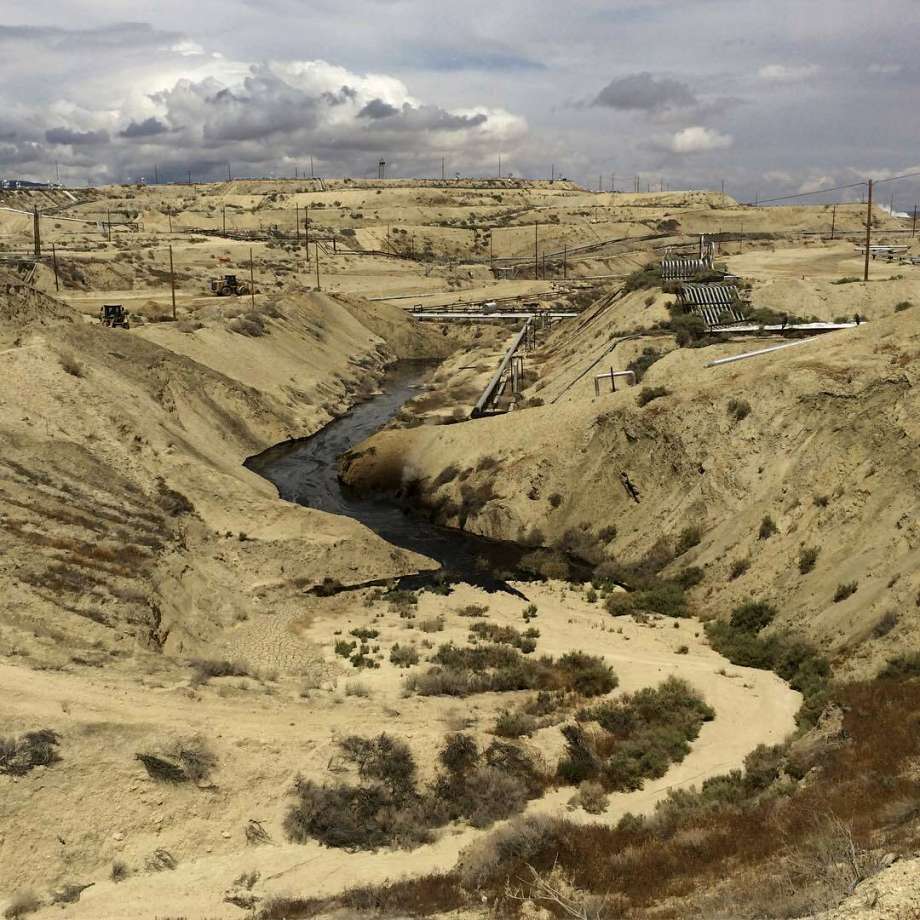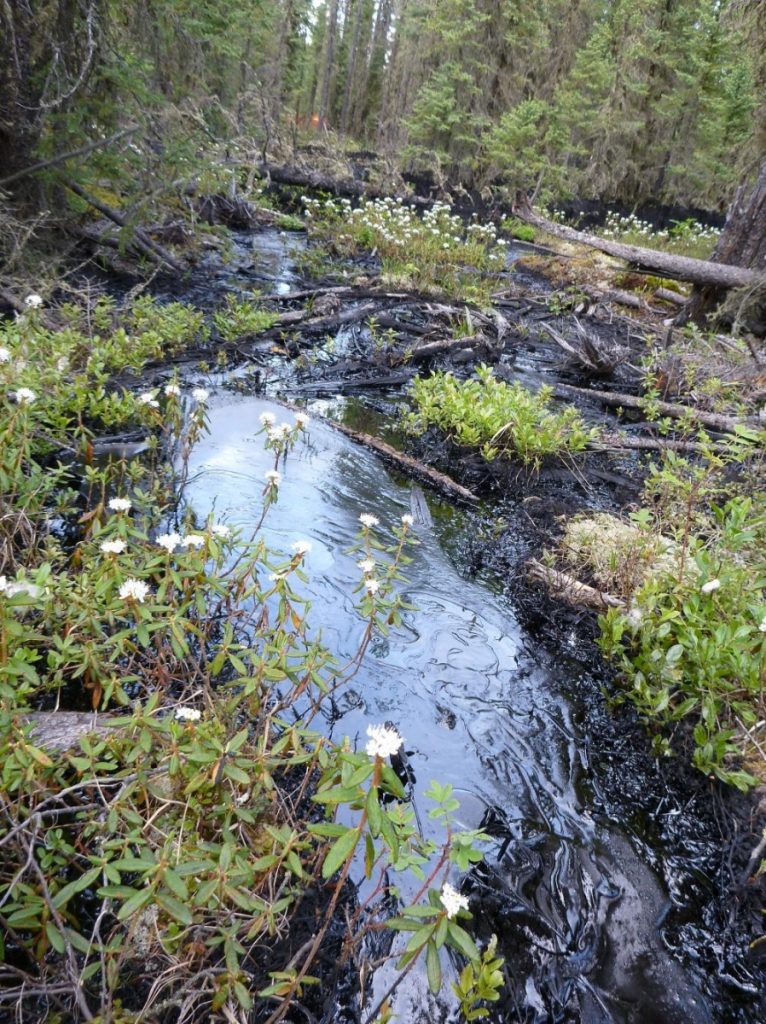***

Snap above from: https://twitter.com/airqualityguy
FRONT PAGE! State orders Chevron to ‘take all measures’ to prevent further leaks of oil, water near McKittrick by John Cox, Jul 15, 2019, The Bakersfield Californian

Snap of Front Page from https://twitter.com/AnnGallon
California’s top oil regulator, losing patience with Chevron’s response to the uncontrolled release of thousands of barrels of oil near McKittrick, has ordered the company to “take all measures” to make sure petroleum, water and steam do not resume rising to the surface after previous efforts to stop the flow there proved temporary.
Asserting Chevron USA Inc. “has not yet done everything that is necessary to prevent future occurrences,” Friday’s order by new Acting State Oil and Gas Supervisor Jason Marshall instructs the company to turn over data and analysis relating to so-called “surface expressions” of oil and water that have left more than 567,000 gallons of black fluid on the ground in a series of at least three releases dating to May at the Cymric Oil Field.
A spokesman for Marshall’s agency, the California Division of Oil, Gas and Geothermal Resources, said oil was still flowing to the surface at the time the order was drafted but that it has since halted. He added that the leak “has stopped and restarted twice previously.”
“The intention is to make sure it does not reactivate again,” spokesman Don Drysdale said by email Monday.
Chevron said in an email Monday it takes such matters seriously, adding, “We will review the order and continue working in a collaborative manner with the involved agencies.” [What crap meaningless mumbo jumbo is that? Why not just stop being so greedy and irresponsible?]
The company declined to address a question about what it thinks is the cause of the surface expressions, which are not permitted in California but which have been a regulatory problem for Chevron as recently as 2011.
VIOLATION NOTICE
DOGGR issued a notice of violation against Chevron May 20 after the company reported a “new high energy surface expression.” The agency ordered the company to perform a root-cause analysis of the leak within 30 days.
Chevron provided the analysis but a DOGGR representative said Monday the agency does not believe the document adequately explains the cause.
In addition to that analysis, the agency told Chevron in May to prepare a monitoring and prevention plan for review by the division no later than Nov. 20. The plan was to include a surveillance system or a pressure and flow monitoring system “that will give adequate warning to prevent surface expressions.”
DOGGR also ordered the company to map the leak, “including cracks, fissures and sink holes related to underground injection work,” as well as plans for restricting access to the area and training for people working in the area.
SECOND VIOLATION
Another notice of violation, issued against Chevron by DOGGR on June 13, noted a separate surface expression June 8 in the same general area. The terms of the second violation mirrored those of the first.
That second notice was amended July 1 after Chevron reported an additional leak there June 23. It noted the agency determined the events “do not meet all of the requirements of a ‘low-energy seep'” and therefore constitute a violation of state rules against underground injection projects resulting in surface expressions. It ordered the company to cease steam injections within 600 feet of the two earlier leaks.
DOGGR provided a summary Friday stating no injuries have been reported in the area and the public was not placed at risk. It said the area’s underlying groundwater has no beneficial use and that noisemakers were being used to keep birds and wildlife away.
REDUCING PRESSURE
…
Steam is used in the Cymric field to heat oil in the area as part of the production process, the agency said. It added that oil, water and steam were surfacing from three vents at the site, and that as a result, a pool of oil and water was created measuring 250 feet by 20 feet.
Surface expressions are generally caused when high-pressure steam used to warm an oil reservoir escapes beyond its intended pathways. This allows the steam to rise to the surface along with oil and water.
Here is a link to Friday’s order: https://www.conservation.ca.gov/dog/Documents/Orders/1159.pdf
[ Will Chevron sue the regulator for daring to do its job? ]
Chevron spills 800,000 gallons of oil, water in California by Don Thompson, Associated Press, July 12, 2019, Chron.com

In this May 10, 2019 photo provided by the California Department of Fish and Wildlife’s Office of Spill Prevention and Response, oil flows at a Chevron oil field in Kern County, Calif. Nearly 800,000 gallons of oil and water has seeped from the ground since May. Chevron and California officials say the spill is not near any waterway and has not significantly affected wildlife. (California Deptartment of Fish and Wildlife’s Office of Spill Prevention and Response via AP) Photo: California Dept. Of Fish And Wildlife, AP / California Department of Fish and Wildlife
SACRAMENTO, Calif. (AP) — Officials began to clean up a massive oil spill Friday that dumped nearly 800,000 gallons of oil and water into a California canyon, making it larger — if less devastating — than the state’s last two major oil spills.
The newly revealed spill has been flowing off and on since May and has again stopped, Chevron spokeswoman Veronica Flores-Paniagua said. She and California officials said the spill is not near any waterway and has not significantly affected wildlife. The last flow was Tuesday.
Chevron reported that 794,000 gallons (about 3 million liters) of oil and water have leaked out of the ground where it uses steam injection to extract oil in the large Cymric Oil Field about 35 miles (56 kilometers) west of Bakersfield. The steam softens the thick crude so it can flow more readily and is a different process from fracking [Not by much], which breaks up underground layers of rock.
The state has issued Chevron a notice of violation ordering it to stop steam injections around the spill. [Compare to Alberta, where the regulators issued no notice of violation, no fine, instead helped Encana cover-up its law violations fracturing directly into a community’s drinking water aquifers. And worse, let the company relentlessly continue fracing hundreds of gas wells into fresh water zones around the impacted community after numerous water wells became too dangerous to use to even flush toilets.]
The company also increased its production of oil from wells in the area. Both actions are intended to relieve underground pressure that may be forcing the mix of oil and water to the surface.
Chevron will pay for the cleanup, though the state will oversee the process, said Steve Gonzalez, a spokesman for the California Department of Fish and Wildlife’s Office of Spill Prevention and Response. [Meanwhile in Alberta, Encana rules the regulator; pays nothing; denies, bullies and lies; makes no apology; refuses to fix the damages and harms done; refuses to turn down its abusive compressor noise; violates written promise after written promise; and cowardly reneges on its promised partnership annual payment to the community theatre, etc.]
The cleanup and the investigation into what caused the oil flow were somewhat delayed as officials ensured there are no dangerous fumes or sinkholes that could trap workers or heavy equipment, he said. [In Canada, officials knowingly ensured families were breathing and living with dangerous fumes in their homes, including deadly sour gas, telling the families – in writing – there was no danger, when there clearly was/is]
“At this point, they have it dammed off and they’re sucking it out, sucking the oil out,” Gonzalez said.
Environmental groups said the Chevron spill is another sign of weakened regulations under an embattled California agency. Gov. Gavin Newsom this week fired the head of the state’s oil and gas division over a recent increase in hydraulic fracturing permits and amid a conflict-of-interest investigation of other division employees.
The Last Chance Alliance, which opposes California’s oil and gas industry, said the state’s Division of Oil, Gas and Geothermal Resources adopted weaker restrictions on steam injection earlier this year, “making these operations even more dangerous.”
The group said state regulators and the U.S. Environmental Protection Agency last year approved an exemption that removed protections from an aquifer in the Cymric Oil Field at the request of Chevron and other oil companies.
“California’s industry-friendly oil regulator continues to provide about as much protection as a screen door on a submarine,” Hollin Kretzmann, a senior attorney at the Center for Biological Diversity and member of the Last Chance Alliance, said in a statement.
Neither Chevron nor division spokesman Don Drysdale commented on the criticism.
About 70% of the fluid is water, Chevron said, meaning about 240,000 gallons (908,472 liters) of the mixture is oil.
The spill, which was first reported by KQED News, comes after a judge earlier this year fined Plains All American Pipeline nearly $3.35 million for causing what had been the worst California coastal spill in 25 years.
A corroded pipeline spilled 140,000 gallons (529,942 liters) of crude oil in 2015 onto Refugio State Beach in Santa Barbara County, northwest of Los Angeles, tarring popular beaches for miles, killing wildlife and harming tourism and fishing.
In 2007, the container ship Cosco Busan leaked nearly 54,000 gallons (204,406 liters) of heavy fuel oil into San Francisco Bay after the ship hit the San Francisco-Oakland Bay Bridge in thick fog.
The state’s worst spill was the 1969 Santa Barbara oil spill that leaked at least 80,000 barrels of crude oil into the Santa Barbara Channel. Each barrel is 42 gallons (159 liters).
But the effect of this year’s Chevron spill on birds and wildlife appears minimal, Gonzalez said. Chevron said the spill flowed into a dry stream bed, and Gonzalez noted that it is unlikely to rain anytime soon. [Arrogant sod! What does he know about what nature will do? Stream beds are called stream beds for a reason!]
“There’s no active waterway that it’s nearby, so that’s the good news,” he said [That’s pathetic news, not good news. What happens to Chevron’s toxic gunk when it rains?]
Chevron spill dumps 800,000 gallons of oil in Kern County by Desert Sun, July 12, 2019
Meanwhile Friday, California authorities said they were preparing to start cleaning up an oil spill that dumped nearly 800,000 gallons of oil and water into a Kern County canyon.
Chevron spokeswoman Veronica Flores-Paniagua said Friday that the seep, which has been flowing off and on since May, has again stopped. She and state officials say the spill is not near any waterway and has not significantly affected wildlife. [Which means it has affected wildlife and knowing how oil patch “regulators” really are pollution/spill cover-uppers extraordinaire, it’s doubtful the truth will ever be told about how much damage was done to wildlife]
However, environmental groups say the spill is another sign of weakened regulations under DOGGR.
Chevron reported that 794,000 gallons of oil and water have leaked out of the ground where it uses steam injection to extract oil in the Cymric Oil Field about 35 miles west of Bakersfield.
Chevron Well at Center of Major Oil Spill in Kern County Oil Field by Ted Goldberg, Jul 12, 2019
…
The initial leak, which state officials call a “surface expression,” lasted 10 hours, said Mary Fricke, a spokeswoman for the Department of Fish and Wildlife’s Office of Spill Prevention and Response, which is monitoring the incident.
Oil began seeping again on June 8 and June 23, according to Don Drysdale, a spokesman for the state’s Division of Oil, Gas, and Geothermal Resources. The discharge was contained in a dry creekbed adjacent to a steam injection well.
Chevron’s reports to the Governor’s Office of Emergency Services show the spill has grown from relatively modest amounts to a major incident, with material flowing from three different points.
On June 11, the company, in a brief incident report to the Governor’s Office of Emergency Services, said that a total of about 6,000 gallons of liquid had spilled by that date. On Thursday, the amount stood at nearly 795,000 gallons — enough oil and water to submerge a football field to a depth of 2½ feet.
The spilled material consists of about one-third oil and two-thirds water, according to Chevron’s entries in the OES hazardous spill database. That would mean nearly 265,000 gallons of oil have been discharged.
…
Currently, the oil and water has been contained to an area that’s 250 feet long and 20 feet wide, according to DOGGR. The agency added that Chevron was using vacuum trucks to suck up the spilled material.
State regulators say they plan to sample the leak to get a more precise estimate on how much of the material is petroleum and find out what caused the leak.
A Chevron executive told state officials earlier this month that a well at the center of the spill was damaged.
“There are multiple damage spots in the well,” Adam Young, a company engineer, wrote in en email to DOGGR officials. It’s unclear if the damage was sustained before or during the spill.
California’s underground injection regulations require operators like Chevron to prevent “surface expressions.” In addition to issuing a notice of violation in the incident, DOGGR ordered the company to stop oil extraction work within a 600-foot radius of the spill.
The agency says Chevron stopped steam injection into wells 1,000 feet around the incident to alleviate pressure in the area.
DOGGR’s Drysdale said about 20 steam injection wells in the area have been taken offline and nine wells that were idle have returned to operation — also to alleviate pressure.
…
Small surface expressions are common in oil fields, according to state officials. Drysdale said the current incident is unusual because three separate vents have allowed fluid to come to the surface.
Hollin Kretzmann, an Oakland-based attorney for the Center for Biological Diversity, said the incident illustrates the hazards that go along with crude oil extraction.
“It underscores the danger of this industry,” Kretzmann said. “Whether it’s pipelines, whether it’s wells, whether it’s refineries, every stage of the process has some sort of risk. Unfortunately in this case, it’s resulted in a large-scale disastrous accident.”
Kretzmann said Chevron’s spill has the potential of hurting local wildlife and future drinking water supplies.
State officials say no one has been injured, there’s no risk to the public and no water that’s used for drinking or farming is affected by the spill.
“The incident is not near any aquifers that would be suitable for beneficial use,” said W. Dale Harvey, an engineer with the Central Valley Regional Water Quality Control Board.
Glenn Fankhauser, Kern County’s agricultural commissioner, said the nearest farm is 6 miles north of the oil field.
Refer also to:
CNRL reports aquifer is contaminated with BTEX 10 km from closest seepage site, How far from steam injection site?
New-found Threat: Researchers discover ancient salt formation key factor in Alberta steam fracking disasters, Review by four engineers finds fractures spread like cracks on a frozen lake, resulting in uncontrolled seepage
Nikiforuk: RECORD BITUMEN SEEPAGE IN ALBERTA CONTINUES UNABATED

2013: CNRL’s bitumen seeping to surface from frac’ing steam injections in Alberta
